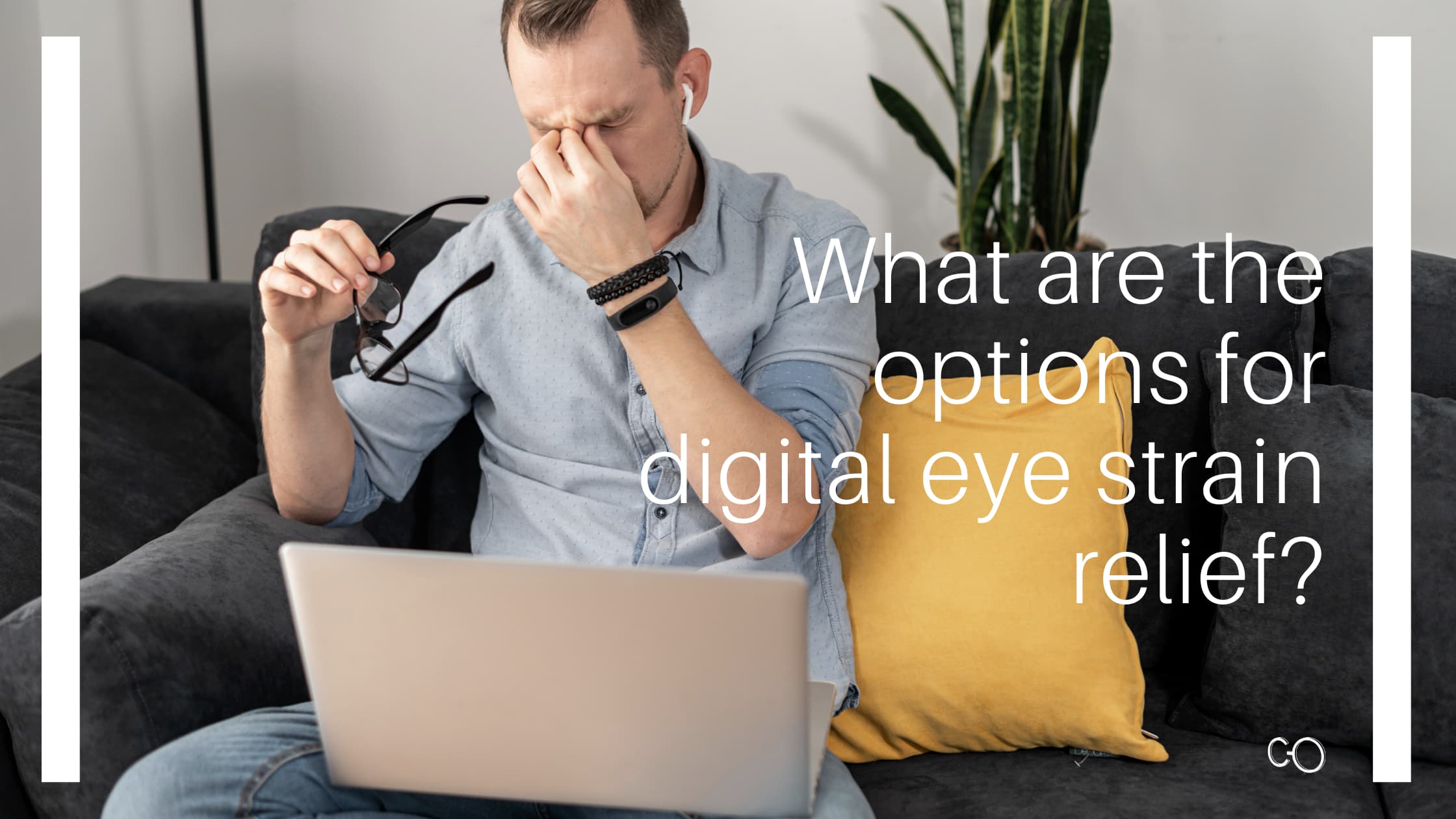It’s rampant that everyone is staring at a computer screen, phone or other digital devices these days, and it’s causing a severe problem called digital eye strain. Computer eye strain is a condition that affects between 50% and 90% of people who spend the majority of their time looking at a computer screen. When looking at digital screens from an intermediate distance, the muscles that control the eye movement are always active and adjusting to the screen. As this activity stretches over a more extended period, with few or no breaks, the eyes can become dry or tired.
Determining symptoms that indicate computer eye strain
Although various factors can cause these symptoms, if you suffer from two or more of the following traits simultaneously and your job requires long hours in front of a screen, they are likely indicative of computer eye strain.
- Dry eye
- Tension headaches
- Eye fatigues
Here are 9 easy steps you can take to reduce your risk of eye strain and other common symptoms of computer vision syndrome:
Undergo a comprehensive eye exam

An eye exam involves a series of tests to evaluate your vision and check for eye diseases. Your eye doctor is likely to use various instruments, shine bright lights at your eyes and request that you look through an array of lenses. Each test during an eye exam evaluates a different aspect of your vision or eye health. During your exam, be sure to tell your eye doctor how often you use a computer and digital devices at work and home. Measure how far your eyes are from your screen when you sit at your computer and bring this measurement to your exam so your optician can test your eyes at that specific working distance.
Use appropriate lighting
Eye strain is often caused by excessively bright light, either from outdoor sunlight coming in through a window or harsh interior lighting. When you use a computer, your ambient lighting should be about half as bright as that typically found in most offices. Reduce interior lighting by using fewer light bulbs or fluorescent tubes, or use lower intensity bulbs and tubes. Many computer users find their eyes feel better if they can avoid working under overhead fluorescent lights. If possible, turn off the overhead fluorescent lights in your office and use floor lamps that provide indirect “soft white” LED lighting instead. Try reducing the number of fluorescent tubes installed above your computer workspace if you are bothered by overhead lighting.
Have a sleeping schedule

Your eyes are refreshed with nutrients and tears during sleep, making a regulated sleeping schedule necessary for healthy and happy eyes. However, sleep deprivation can cause the blood vessels in your eyes to dilate, leading to irritation and eye fatigue during the day.
A set work schedule and a regulated sleeping cycle will help you reset your eyes at the end of the day and ensure that you get appropriate rest overnight. To relax in the evening, try to avoid looking at screens, including TVs and smartphones, as the blue light from digital screens has been linked to promoting brain activity. Instead, try building a nighttime routine that includes tasks like cooking or tidying.
Adjust your computer display settings
Adjusting the display settings of your computer can help reduce eye strain and fatigue. Generally, these adjustments are beneficial:
- Brightness: Adjust the brightness of the display so it’s approximately the same as the brightness of your surrounding workstation.
- Text size and contrast: Regulate the text size and contrast for comfort, especially when reading or composing long documents. Usually, black print on a white background is the best combination for comfort.
- Colour temperature: This is the spectrum of visible light emitted by a colour display. Blue light is short-wavelength visible light associated with more eye strain than longer wavelength hues, such as orange and red. Reducing your display’s colour temperature lowers the amount of blue light emitted by a colour display for better long-term viewing comfort.
Blink more often
Blinking is very important when working at a computer; it moistens your eyes to prevent dryness and irritation.
What happens when you blink less?
If you become aware that you blink less, ideally, you can try to make a habit of blinking more often. However, as this adjustment isn’t always possible to achieve, you can try setting a reminder every 20 minutes. Also, you can use this time to blink slowly or close your eyes completely. Please do it approximately ten times in a row and focus on a spot far away from your desk to relax your eye muscles.
What happens when you stare at a computer for too long?
Research reveals that when staring at a computer screen or reading for a prolonged period, people blink up to two thirds less frequently than usual. However, it often happens when only closing the lids partially instead of covering the eyes completely. It causes the tear film to evaporate and the eyesight to feel dry and uncomfortable.
The importance of blinking your eyes
Blinking is very important when working at a computer. It aids moistens your eyes to prevent dryness and irritation. According to studies, when staring at a screen, people blink less frequently — only about one-third as often as they usually do — and many blinks performed during computer work are only partial lid closures. Also, tears coating the eye evaporate more rapidly during long non-blinking phases, and this can cause dry eyes. Furthermore, the air in many office environments is dry. This can increase how quickly your tears evaporate, placing you at greater risk for dry eye problems.
By the way, you should not confuse lubricating eye drops with the drops formulated to “get the red out.” The latter can indeed make your eyes look better because they contain ingredients that reduce the size of blood vessels on the surface of your eyes to “whiten” them. But they are not necessarily formulated to reduce dryness and irritation.
If you experience dry eye symptoms, ask your optician about artificial tears for use during the day.
Have an eye exercise routine
Another cause of computer eye strain is focusing fatigue.
The 20-20-20 rule
This rule helps to reduce your risk of tiring your eyes by constantly focusing on your screen. Always look away from your computer at least every 20 minutes and gaze at a distant object (at least 20 feet away) for at least 20 seconds. Some opticians call this the “20-20-20 rule.” Looking far away relaxes the focusing muscle inside the eye to reduce fatigue.
Another eye exercise is :
To look far away at an object for 10-15 seconds, then gaze at something up close for 10-15 seconds. Then look back at the distant object. Do this ten times often. This exercise reduces the risk of your eye’s focusing ability locking up (a condition called accommodative spasm) after prolonged computer work.
Both of these exercises will reduce your risk of computer eye strain. Also, remember to blink frequently during the activities to reduce your risk of computer-related dry eye.
Take constant breaks
To reduce your risk for computer vision syndrome, neck, back, and shoulder pain, take frequent screen breaks during your workday (at least one 10-minute break every hour). Scheduling time away from the computer screen gives not only your eyes but also your mind a chance to relax and unwind. During these breaks, stand up, move about and stretch your arms, legs, back, neck and shoulders to reduce tension and muscle fatigue.
Modify your workstation

Position your computer screen, so it’s 20 to 24 inches from your eyes. The centre of your screen should be about 10 to 15 degrees below your eyes for comfortable positioning of your head and neck. Poor posture also contributes to computer vision syndrome. Adjust your workstation and chair to the correct height, so your feet rest comfortably on the floor.
Get computer glasses

For the most incredible comfort at your computer, you might benefit from having your optician modify your eyeglasses prescription to create customised computer glasses. This is especially true if you normally wear contact lenses, which may become dry and uncomfortable during extended screen time.
Consider the following option for your usage:
Computer glasses also are a good choice if you wear bifocals or progressive lenses because these lenses generally are not optimal for the distance to your computer screen.
Also, you may want to consider photochromic lenses or lightly tinted lenses for computer eyewear to reduce your exposure to potentially harmful blue light emitted by digital devices. Ask your optician for details and advice.
ARE YOU FEELING COMPUTER EYE STRAIN? Find an optician near you.
Call us on 0161 665 3673 to book an appointment with us now! Follow us on Facebook and Instagram @chaddertonopticians for the latest eye health news.


